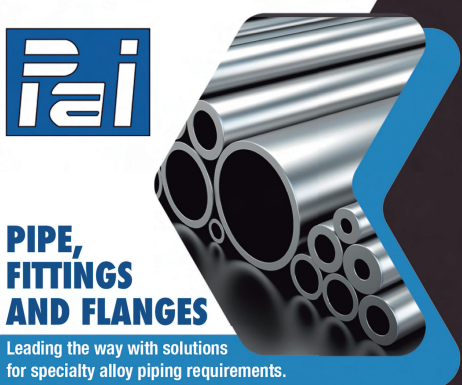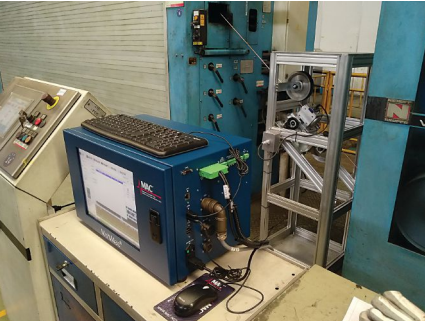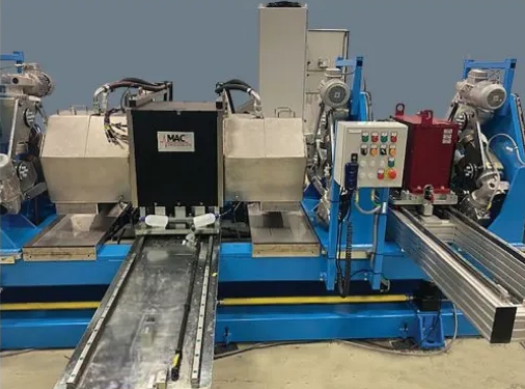INTERWIRE, ATLANTA, GA 2023
Troy M Libby
Magnetic Analysis Corporation
tlibby@mac-ndt.com
914-530-2000 x 137
Eddy Current inspection is a technique used for detecting surface seams, cracks, pits, slivers, and internal discontinuities in ferrous and non-ferrous wire. Different test sensor configurations, including encircling coil and rotary probes, can be used. When using encircling coil eddy current testing, the wire passes through the coil excited by an alternating current with one or more drive signals. Rotary probe inspection can reliably detect surface seams and cracks using eddy currents induced by one or more probes traversing the surface of the material under test. Wire sizes can range from ultra-fine below .002” (.051mm), fine wire .002”(.051mm) to .005”(.127mm), and standard wire .006”(.152mm) to .725”(18.42mm). Encircling coil testing can be used for the whole range, whereas rotary probe inspection can only be used above .200” (5.08mm).
The composition of the material under test influences the selection of the test frequency, as does the size of the material. Usually, materials with very low conductivity and small dimensions require a higher test frequency from 1MHZ to 5MHZ and will be tested with smaller wire-tester-type coils. Rotary inspection is used on larger material for detecting longitudinal defects. Depending on the length and depth of the defect, as well as the speed of the rotary and line, the proper probe element can be determined. This paper will discuss the advantages obtained by using different eddy current methods for testing wire products.
Introduction
Before selecting an eddy current test coil and mode, it is important to know what type of defects need to be detected and the characteristics, such as type of product and dimensions, that are being inspected.
Coil Selection
The coils can be either absolute or differential mode. Some equipment permits the use of both methods simultaneously. Coils can be wound with different physical characteristics. This includes the use of multiple coil windings electrically connected in different configurations, as well as their width and spacing. The purpose of these different coil systems is to improve the detection of specific types of defects. Absolute testing is useful for mean wall thickness, mean diameter, and conductivity measurements. Flaw testing is restricted to detecting short variations that can lie on the surface or subsurface of the material under test. To ensure equal test results on a product that does not have a round cross-section, coils may be manufactured to conform to the cross-section of the product (a shaped coil can be manufactured).
Absolute or Differential Test Modes Used for Testing Wire
In actual testing, a single coil system (absolute mode) or a system of two or more coil windings that electrically subtract from each other (differential mode) may be used to detect defects.
When the absolute mode is used, the output of the coil containing acceptable material is fed into the electronics, and variations from this norm are detected. When the coils are connected in the differential mode, they continually test and compare adjacent segments of the material as it passes through the coils. If there is "good" material in both coils, the resulting difference is zero. In electronic terms, when the absolute mode is used, the change seen by the electronics is the difference between the biasing voltage output for good material and the change in this voltage caused by a defect passing through the coil. For example, if a defect causes a change of 1 volt in the output of the coil, and the normal output of the coil is 10 volts, then the electronics sees a 10% change. When using the differential mode, the same defect would theoretically produce an infinite change as the difference, and the electronics would register 1 volt as compared to zero. The two modes are illustrated in the diagram below.
Generally, a differential mode system is more sensitive to intermittent defects because one section of material is being compared to the next. However, with long, uniform discontinuities, a differential mode system may indicate only the beginning and the end, and nothing in between. Conversely, the absolute mode would signal for the complete length of the defect. However, the ability of the differential mode to detect smaller changes and to produce a better flaw signal-to-noise ratio makes it more suitable for general applications.
Another coil option, called a Dual Coil configuration, uses two coils: one for flaw detection and a second for detecting ferrous inclusions in non-ferrous materials, both supplying test results to the instrument through a single cable connection.




